The Higher Education Sustainability through Virtual Laboratories: The Spanish University as Case of Study
Abstract
1. Introduction
- -
- Can be either local or remote access,
- -
- The experiences are closer to a larger number of students,
- -
- No limit to the number of opportunities,
- -
- Experiencing without risk,
- -
- No equipment can be damaged while learning how to use them,
- -
- No laboratory equipment used,
- -
- The place and time of the practices are made more flexible,
- -
- A self-study mode can be considered where the input variables can be modified by the student,
- -
- They do not provide the same enriching experience as direct practice,
- -
- The student may behave like a viewer,
- -
- Laboratory reality can be distorted (if a proper simulation is not available), and
- -
- Loss of teamwork skill due to excessive individualism on the part of the student.
- To systematically classify and quantify the published literature on virtual laboratories. Specifically, this analysis will focus on its trend over time, types of publications and countries that are involved in this research.
- To highlight which are the main subjects’ categories and keywords from the worldwide publications on this topic.
- To highlight which are the most productive institutions (affiliations), which are their main topics, including their bibliometric indicators and their possible relationship in terms of available resources.
- A representative country will be studied in depth as a case of study, to analyze how this scientific environment is among the universities, the main collaborators with these institutions, and the clusters associated with virtual laboratories publications and their main evolution over time.
2. Methodology
- Global Data extraction. The main query has been made in the Scopus database: TITLE-ABS-KEY (virtual AND lab*). Each record contains the following subfields in CSV format (comma-separated values): Authors, Author Ids, Title, Year, Source title, Volume, Issue, Art. No., Page start, Page end, Page count, Cited by, DOI, Link, Document Type, Access Type, Source, EID.
- Global Bibliometric data analysis. Thus, each subfield can be saved separately and analysed. For example, an analysis can be carried out to identify which are the main institutions or countries in this field.
- Selection of a representative country as a case study. Among the countries that publish more than 1% of the world’s scientific production on the topic of virtual laboratories, the one that is closest to the mean will be selected to be explored in detail. In this case, the search in the Scopus database will be TITLE-ABS-KEY (virtual AND lab*) AND (LIMIT-TO (AFFILCOUNTRY, “Selected country”)).
- Community detection. To see the research trends of the selected country, the community detection will be applied. This will allow us to group the scientific fields around which the scientific research is grouped in the selected country. The community detection of thematic clusters (community or cluster detection) was analyzed with VOSviewer (version, Manufacturer, City, US State abbrev. if applicable, Country) [26].
3. Results and Discussion
3.1. Trend over Time, Types of Publications and Countries
3.2. Subjects and Keywords from Worldwide Publications
3.3. Affiliations and Their Main Topics
3.4. Journals and Procedings Metric Analysis
4. The Case Study: Spanish Universities
4.1. Trend over Time and Types of Publications in Spanish Universities
4.2. Affiliation and Its International Collaboration
4.3. Subject Categories
4.4. Keywords
5. Discussion
6. Conclusions
Author Contributions
Funding
Conflicts of Interest
References
- Au-Yong-Oliveira, M.; Gonçalves, R.; Martins, J.; Branco, F. The social impact of technology on millennials and consequences for higher education and leadership. Telemat. Inform. 2018, 35, 954–963. [Google Scholar] [CrossRef]
- Alshuwaikhat, H.M.; Adenle, Y.A.; Saghir, B. Sustainability Assessment of Higher Education Institutions in Saudi Arabia. Sustainability 2016, 8, 750. [Google Scholar] [CrossRef]
- García-Peñalvo, F.J.; Fidalgo-Blanco, Á.; Sein-Echaluce, M.L. An adaptive hybrid MOOC model: Disrupting the MOOC concept in higher education. Telemat. Inform. 2018, 35, 1018–1030. [Google Scholar] [CrossRef]
- Moreira, F.; Ferreira, M.J.; Santos, C.P.; Durão, N. Evolution and use of mobile devices in higher education: A case study in Portuguese Higher Education Institutions between 2009/2010 and 2014/2015. Telemat. Inform. 2017, 34, 838–852. [Google Scholar] [CrossRef]
- Kang, D.; Park, M.J. Competitive prospects of graduate program on the integration of ICT superiority, higher education, and international aid. Telemat. Inform. 2017, 34, 1625–1637. [Google Scholar] [CrossRef]
- Aparicio-Martínez, P.; Perea-Moreno, A.J.; Martinez-Jimenez, M.P.; Varo, I.S.V.; Vaquero-Abellán, M. Social networks’ unnoticed influence on body image in Spanish university students. Telemat. Inform. 2017, 34, 1685–1692. [Google Scholar] [CrossRef]
- Ramirez, G.M.; Collazos, C.A.; Moreira, F. All-Learning: The state of the art of the models and the methodologies educational with ICT. Telemat. Inform. 2018, 35, 944–953. [Google Scholar] [CrossRef]
- Bermejo, S. Cooperative electronic learning in virtual laboratories through forums. IEEE Trans. Educ. 2005, 48, 140–149. [Google Scholar] [CrossRef]
- Cabedo, L.; Royo, M.; Moliner, L.; Guraya, T. University social responsibility towards engineering undergraduates: The effect of methodology on a service-learning experience. Sustainability 2018, 10, 1823. [Google Scholar] [CrossRef]
- Heradio, R.; de la Torre, L.; Dormido, S. Virtual and remote labs in control education: A survey. Annu. Rev. Control. 2016, 42, 1–10. [Google Scholar] [CrossRef]
- Jiménez-Torres, M.; Rus-Casas, C.; Lemus-Zúiga, L.G.; Hontoria, L. The Importance of Accurate Solar Data for Designing Solar Photovoltaic Systems—Case Studies in Spain. Sustainability 2017, 9, 247. [Google Scholar] [CrossRef]
- Ko, C.C.; Chen, B.M.; Hu, S.; Ramakrishnan, V.; Cheng, C.D.; Zhuang, Y.; Chen, J. A web-based virtual laboratory on a frequency modulation experiment. IEEE Trans. Syst. Man Cybern. Part C (Appl. Rev.) 2001, 31, 295–303. [Google Scholar]
- Paredes-Labra, J.; Siri, I.M.; Oliveira, A. Preparing Public Pedagogies with ICT: The Case of Pesticides and Popular Education in Brazil. Sustainability 2018, 10, 3377. [Google Scholar] [CrossRef]
- Zajko, K.; Bradač Hojnik, B. Social Franchising Model as a Scaling Strategy for ICT Reuse: A Case Study of an International Franchise. Sustainability 2018, 10, 3144. [Google Scholar] [CrossRef]
- Gravier, C.; Fayolle, J.; Bayard, B.; Ates, M.; Lardon, J. State of the art about remote laboratories paradigms-foundations of ongoing mutations. Int. J. Online Eng. 2008, 4, 19–25. [Google Scholar]
- Potkonjak, V.; Gardner, M.; Callaghan, V.; Mattila, P.; Guetl, C.; Petrović, V.M.; Jovanović, K. Virtual laboratories for education in science, technology, and engineering: A review. Comput. Educ. 2016, 95, 309–327. [Google Scholar] [CrossRef]
- Merchant, Z.; Goetz, E.T.; Cifuentes, L.; Keeney-Kennicutt, W.; Davis, T.J. Effectiveness of virtual reality-based instruction on students’ learning outcomes in K-12 and higher education: A meta-analysis. Comput. Educ. 2014, 70, 29–40. [Google Scholar] [CrossRef]
- Salmerón-Manzano, E.; Manzano-Agugliaro, F. Worldwide scientific production indexed by Scopus on Labour Relations. Publications 2017, 5, 25. [Google Scholar] [CrossRef]
- Bar-Ilan, J. Citations to the “Introduction to informetrics” indexed by WOS, Scopus and Google Scholar. Scientometrics 2010, 82, 495–506. [Google Scholar] [CrossRef]
- Mongeon, P.; Paul-Hus, A. The journal coverage of Web of Science and Scopus: A comparative analysis. Scientometrics 2016, 106, 213–228. [Google Scholar] [CrossRef]
- Archambault, É.; Campbell, D.; Gingras, Y.; Larivière, V. Comparing bibliometric statistics obtained from the Web of Science and Scopus. J. Am. Soc. Inf. Sci. Technol. 2009, 60, 1320–1326. [Google Scholar] [CrossRef]
- Gimenez, E.; Salinas, M.; Manzano-Agugliaro, F. Worldwide research on plant defense against biotic stresses as improvement for sustainable agriculture. Sustainability 2018, 10, 391. [Google Scholar] [CrossRef]
- De la Cruz-Lovera, C.; Perea-Moreno, A.J.; de la Cruz-Fernández, J.L.; Alvarez-Bermejo, J.A.; Manzano-Agugliaro, F. Worldwide research on energy efficiency and sustainability in public buildings. Sustainability 2017, 9, 1294. [Google Scholar] [CrossRef]
- Gimenez, E.; Manzano-Agugliaro, F. DNA Damage Repair System in Plants: A Worldwide Research Update. Genes 2017, 8, 299. [Google Scholar] [CrossRef] [PubMed]
- Hernández-Escobedo, Q.; Perea-Moreno, A.J.; Manzano-Agugliaro, F. Wind energy research in Mexico. Renew. Energy 2018, 123, 719–729. [Google Scholar] [CrossRef]
- Van Eck, N.; Waltman, L. Software survey: VOSviewer, a computer program for bibliometric mapping. Scientometrics 2009, 84, 523–538. [Google Scholar] [CrossRef] [PubMed]
- Paskin, N. Digital object identifier (DOI®) system. Encycl. Libr. Inf. Sci. 2010, 3, 1586–1592. [Google Scholar]
- Verborgh, R.; De Wilde, M. Using OpenRefine; Packt Publishing Ltd.: Birmingham, UK, 2013. [Google Scholar]
- El Khaled, D.; Novas, N.; Gazquez, J.A.; Manzano-Agugliaro, F. Dielectric and bioimpedance research studies: A Scientometric approach using the scopus database. Publications 2018, 6, 6. [Google Scholar] [CrossRef]
- Montoya, F.; Baños, R.; Alcayde, A.; Montoya, M.; Manzano-Agugliaro, F. Power Quality: Scientific Collaboration Networks and Research Trends. Energies 2018, 11, 2067. [Google Scholar] [CrossRef]
- Garrido-Cardenas, J.A.; Mesa-Valle, C.; Manzano-Agugliaro, F. Trends in plant research using molecular markers. Planta 2017, 247, 543–557. [Google Scholar] [CrossRef] [PubMed]
- Garrido-Cardenas, J.A.; Mesa-Valle, C.; Manzano-Agugliaro, F. Genetic approach towards a vaccine against malaria. Eur. J. Clin. Microbiol. Infect. 2018, 37, 1829–1839. [Google Scholar] [CrossRef] [PubMed]
- Garrido-Cardenas, J.A.; Mesa-Valle, C.; Manzano-Agugliaro, F. Human parasitology worldwide research. Parasitology 2018, 145, 699–712. [Google Scholar] [CrossRef] [PubMed]
- Salmerón-Manzano, E.M. Análisis de las competencias genéricas de la Universidad de Almería en el Grado en Derecho en relación al mercado laboral. Espiral Cuadernos Profesorado 2017, 10, 58–72. [Google Scholar] [CrossRef]
- MECD. 2016. Available online: https://www.mecd.gob.es/dms/mecd/servicios-al-ciudadano-mecd/estadisticas/educacion/universitaria/datos-cifras/datos-y-cifras-SUE-2015-16-web-.pdf (accessed on 10 August 2018).
- Allen, I.E.; Seaman, J. Changing Course: Ten Years of Tracking Online Education in the United States. 2013; p. 47. Available online: https://files.eric.ed.gov/fulltext/ED541571.pdf (accessed on 10 August 2018).
- Aznar-Sánchez, J.A.; Belmonte-Ureña, L.J.; Velasco-Muñoz, J.F.; Manzano-Agugliaro, F. Economic analysis of sustainable water use: A review of worldwide research. J. Clean. Prod. 2018, 198, 1120–1132. [Google Scholar] [CrossRef]
- Salmeron-Manzano, E.; Manzano-Agugliaro, F. The Electric Bicycle: Worldwide Research Trends. Energies 2018, 11, 1894. [Google Scholar] [CrossRef]
- Redel-Macías, M.D.; Pinzi, S.; Martínez-Jiménez, M.P.; Dorado, G.; Dorado, M.P. Virtual laboratory on biomass for energy generation. J. Clean. Prod. 2016, 112, 3842–3851. [Google Scholar] [CrossRef]
- Pérez-Romero, A.M.; Castro-Garcia, M.; León-Bonillo, M.J.; Manzano-Agugliaro, F. Learning effectiveness of virtual environments for 3D terrain interpretation and data acquisition. Surv. Rev. 2017, 49, 302–311. [Google Scholar] [CrossRef]
- Manzano-Agugliaro, F.; Salmerón-Manzano, E.; Perea-Moreno, A.J. Las competencias transversales de las universidades del campus de excelencia agroalimentario (CEI-A3). Espiral Cuadernos Profesorado 2016, 4, 3–12. [Google Scholar] [CrossRef]
- Padilla, F.M.; Gallardo, M.; Manzano-Agugliaro, F. Global trends in nitrate leaching research in the 1960–2017 period. Sci. Total. Environ. 2018, 643, 400–413. [Google Scholar] [CrossRef] [PubMed]
- Garrido-Cardenas, J.A.; Manzano-Agugliaro, F.; Acien-Fernandez, F.G.; Molina-Grima, E. Microalgae research worldwide. Algal Res. 2018, 35, 50–60. [Google Scholar] [CrossRef]
- Montoya, F.G.; Alcayde, A.; Baños, R.; Manzano-Agugliaro, F. A fast method for identifying worldwide scientific collaborations using the Scopus database. Telemat. Inform. 2018, 35, 168–185. [Google Scholar] [CrossRef]
- Garcia-Zubia, J.; Cuadros, J.; Romero, S.; Hernandez-Jayo, U.; Orduña, P.; Guenaga, M.; Gustavsson, I. Empirical analysis of the use of the VISIR remote lab in teaching analog electronics. IEEE Trans. Educ. 2017, 60, 149–156. [Google Scholar] [CrossRef]
- Dormido, S. Control learning: Present and future. Annu. Rev. Control. 2004, 28, 115–136. [Google Scholar]
- Shin, D.H. The role of affordance in the experience of virtual reality learning: Technological and affective affordances in virtual reality. Telemat. Inform. 2017, 34, 1826–1836. [Google Scholar] [CrossRef]
- Manzano-Agugliaro, F.; Castro-García, M.; Pérez-Romero, A.M.; García-Cruz, A.; Novas, N.; Salmerón-Manzano, E. Alternative methods for teaching cadastre and remote sensing. Surv. Rev. 2016, 48, 450–459. [Google Scholar] [CrossRef]
- Salmerón-Manzano, E.; Alcayde, A.; Montoya, F.G.; Novas Castellano, N.; García-Salvador, R.; Garrido-Cárdenas, J.A.; Martínez-Lao, J.A.; Zapata-Sierra, A.J.; Fernández-Ros, M.; Soler-Ortiz, M.; et al. Smartphone as an interactive learning tool: Assessment of the use in university teaching. In Proceedings of the 10th International Conference on Education and New Learning Technologies, Palma, Spain, 2–4 July 2018; pp. 3607–3614. [Google Scholar]
- Virtanen, M.A.; Kääriäinen, M.; Liikanen, E.; Haavisto, E. The comparison of students’ satisfaction between ubiquitous and web-basedlearning environments. Educ. Inf. Technol. 2017, 22, 2565–2581. [Google Scholar] [CrossRef]
- Huang, Y.C.; Backman, S.J.; Backman, K.F.; McGuire, F.A.; Moore, D. An investigation of motivation and experience in virtual learning environments: A self-determination theory. Educ. Inf. Technol. 2018, in press. [Google Scholar] [CrossRef]
- Case, J.M.; Light, G. Emerging research methodologies in engineering education research. J. Eng. Educ. 2011, 100, 186–210. [Google Scholar] [CrossRef]
- Singer, S.; Smith, K.A. Discipline-based education research: Understanding and improving learning in undergraduate science and engineering. J. Eng. Educ. 2013, 102, 468–471. [Google Scholar] [CrossRef]
- Hayward, P.A. A comparison of face-to-face and virtual software development teams. Team Perform. Manag. Int. J. 2002, 8, 39–48. [Google Scholar]
- Hoegl, M.; Proserpio, L. Team member proximity and teamwork in innovative projects. Res. Policy 2004, 33, 1153–1165. [Google Scholar] [CrossRef]
- Koretsky, M.D.; Amatore, D.; Barnes, C.; Kimura, S. Enhancement of student learning in experimental design using a virtual laboratory. IEEE Trans. Educ. 2008, 51, 76–85. [Google Scholar] [CrossRef]
- Purvanova, R.K.; Bono, J.E. Transformational leadership in context: Face-to-face and virtual teams. Leadersh. Q. 2009, 20, 343–357. [Google Scholar] [CrossRef]
- Velosa-García, J.D.; Castillo-García, F.J.; Espíldora, E.; Cobo, L. Requirements for hybrid laboratories in Manufacturing Engineering. Dyna 2017, 84, 65–74. [Google Scholar] [CrossRef]
- Perea-Moreno, A.J.; Salmerón-Manzano, E.M.; Laguna-Luna, A.M.; Aguilera-Ureña, M.J.; Manzano-Agugliaro, F. Experiencias de aprendizaje activo mediante Clickers en prácticas universitarias. Espiral Cuadernos Profesorado 2017, 10, 16–27. [Google Scholar] [CrossRef]
- Lang, D.; Mengelkamp, C.; Jaeger, R.S.; Geoffroy, D.; Billaud, M.; Zimmer, T. Pedagogical evaluation of remote laboratories in eMerge project. Eur. J. Eng. Educ. 2007, 32, 57–72. [Google Scholar] [CrossRef]
- Kara, A.; Ozbek, M.E.; Cagiltay, N.E.; Aydin, E. Maintenance, sustainability and extendibility in virtual and remote laboratories. Procedia Soc. Behav. Sci. 2011, 28, 722–728. [Google Scholar] [CrossRef]
- Wiedmann, T. An input–output virtual laboratory in practice–survey of uptake, usage and applications of the first operational IELab. Econ. Syst. Res. 2017, 29, 296–312. [Google Scholar] [CrossRef]
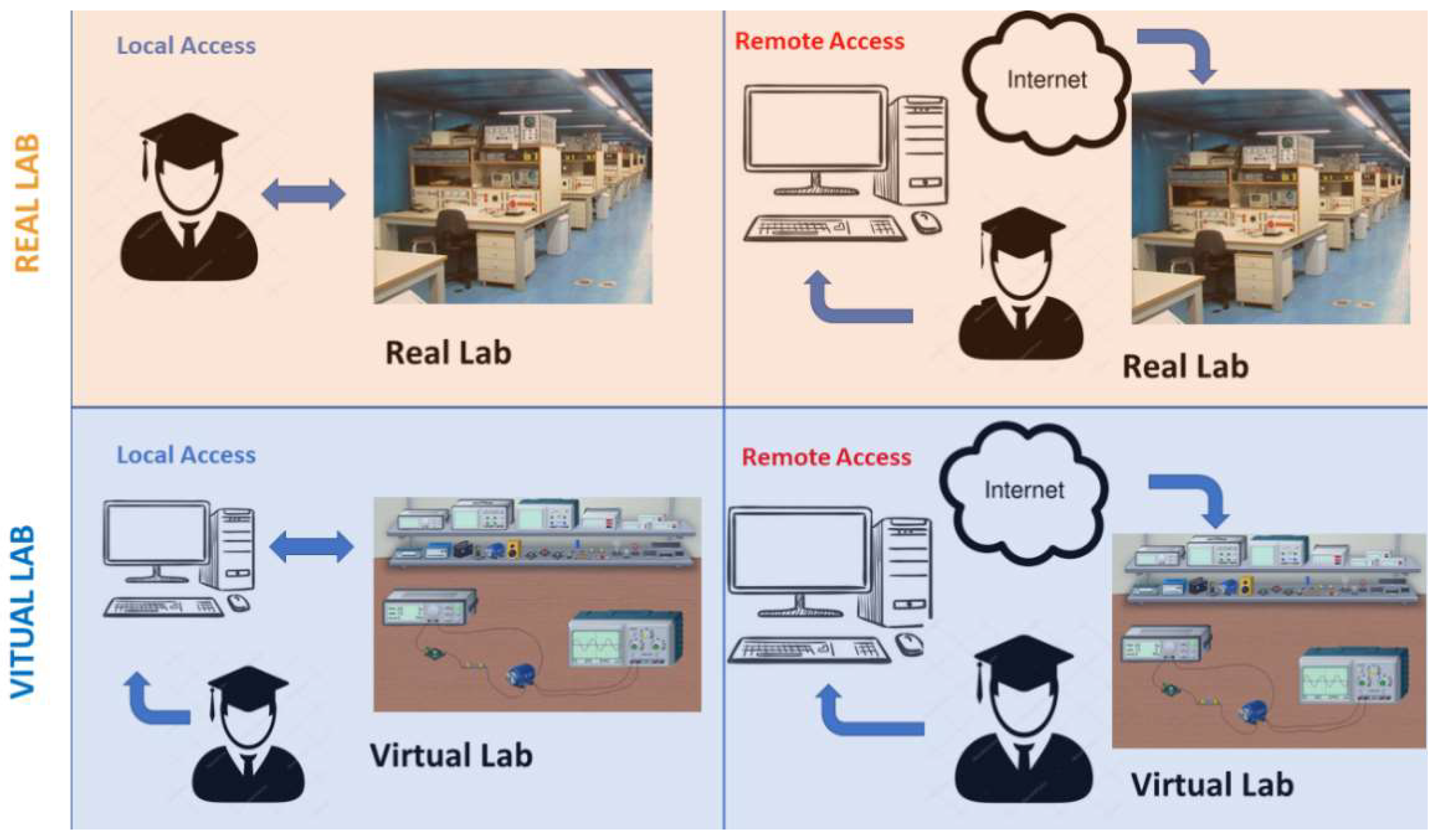

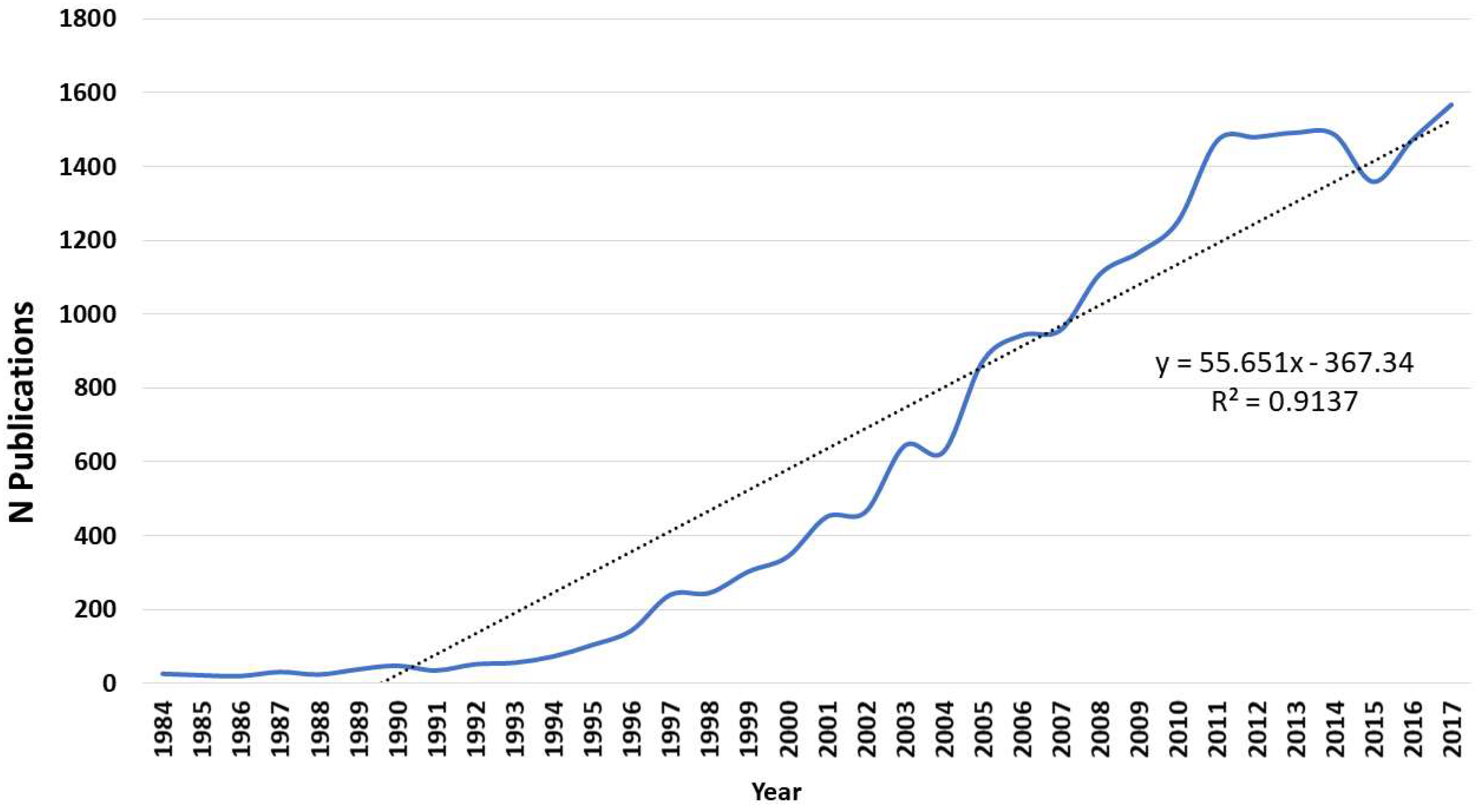
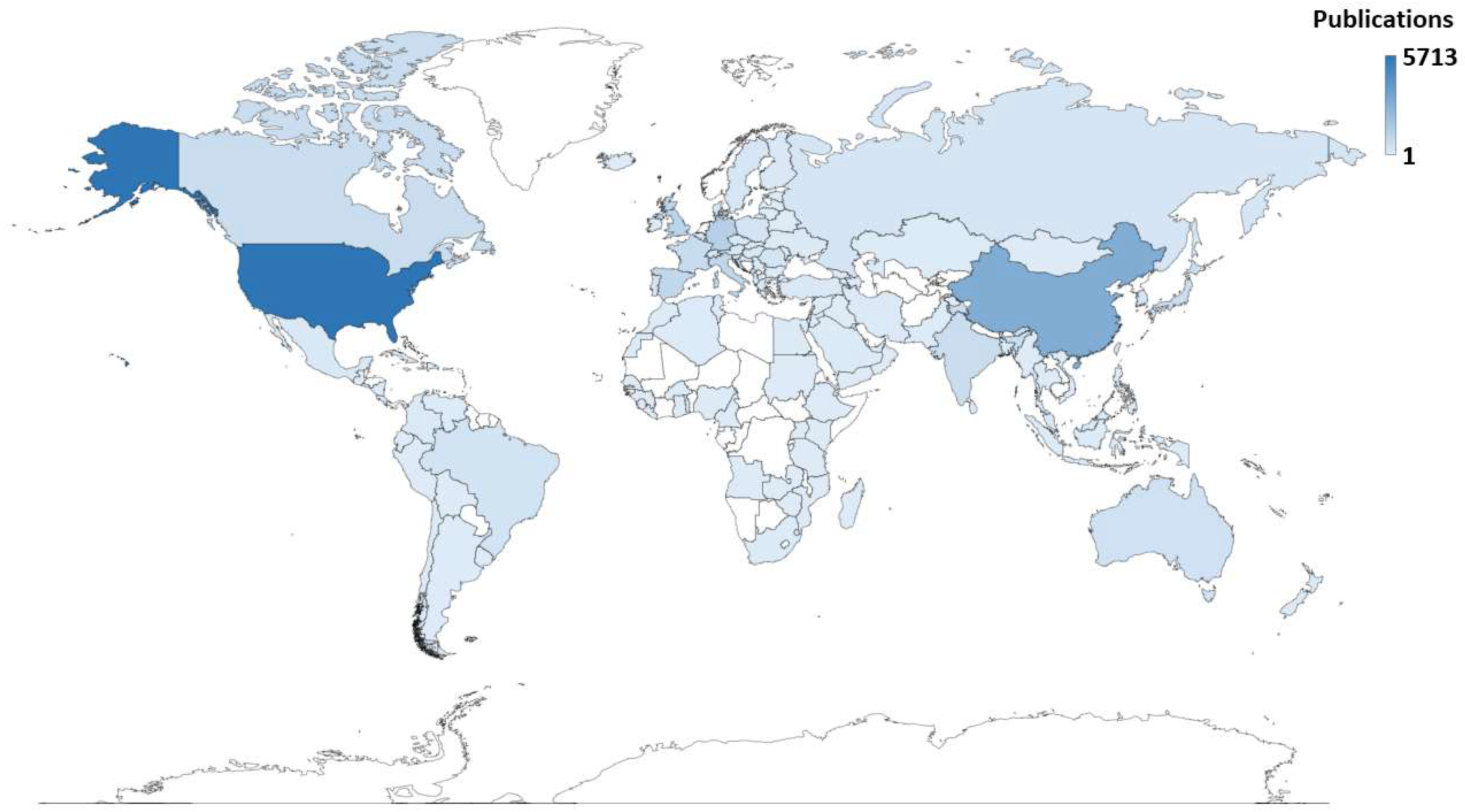
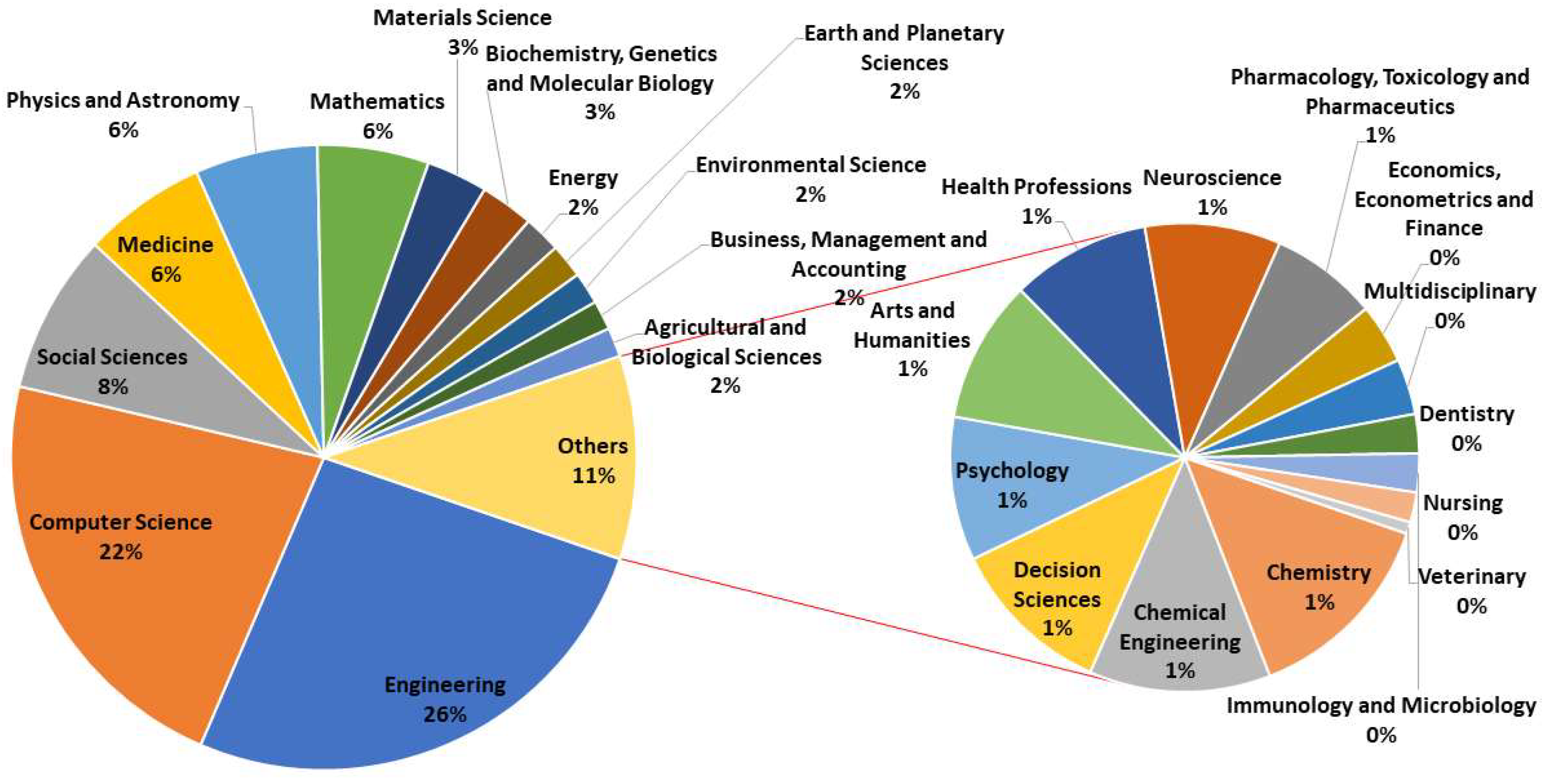
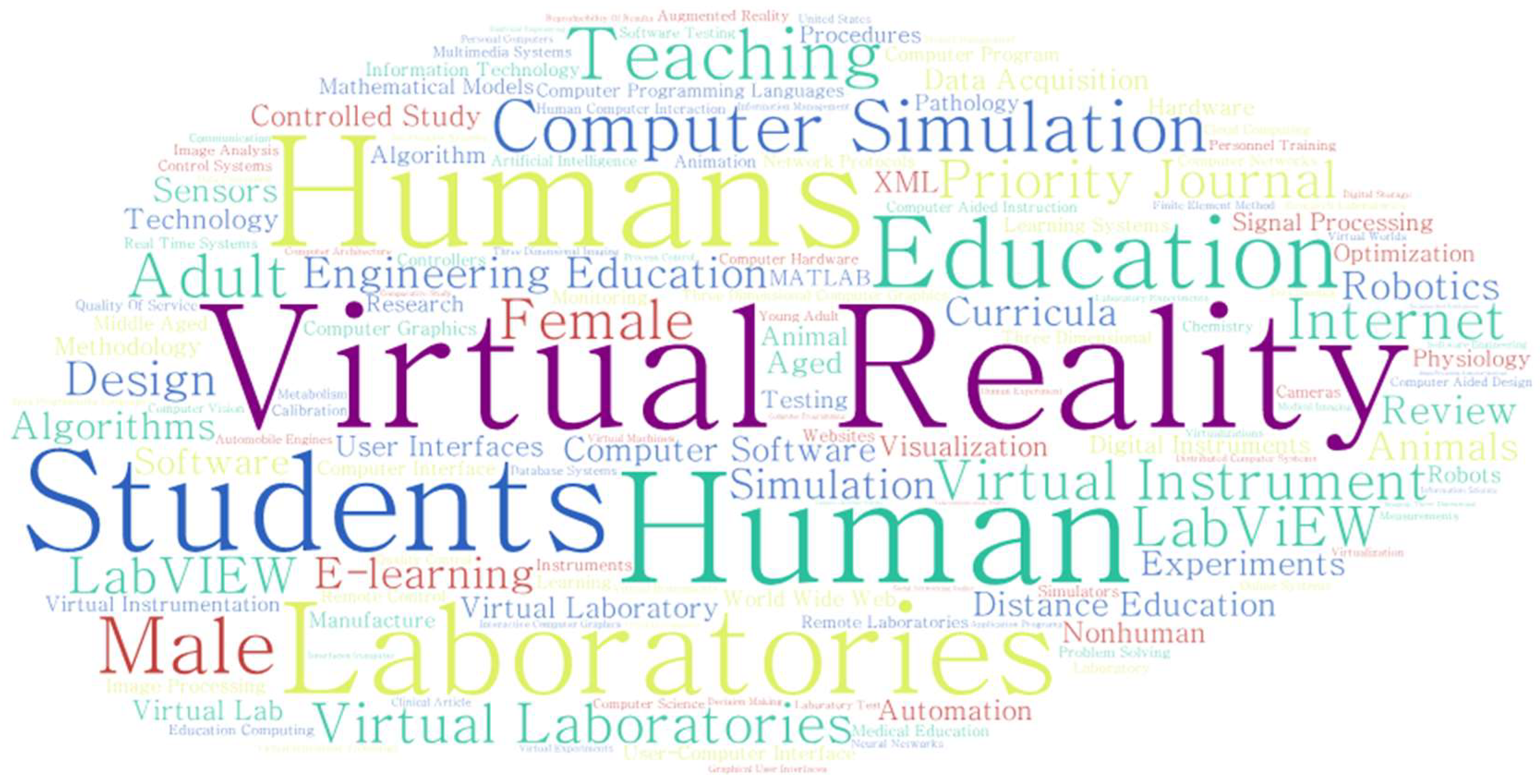
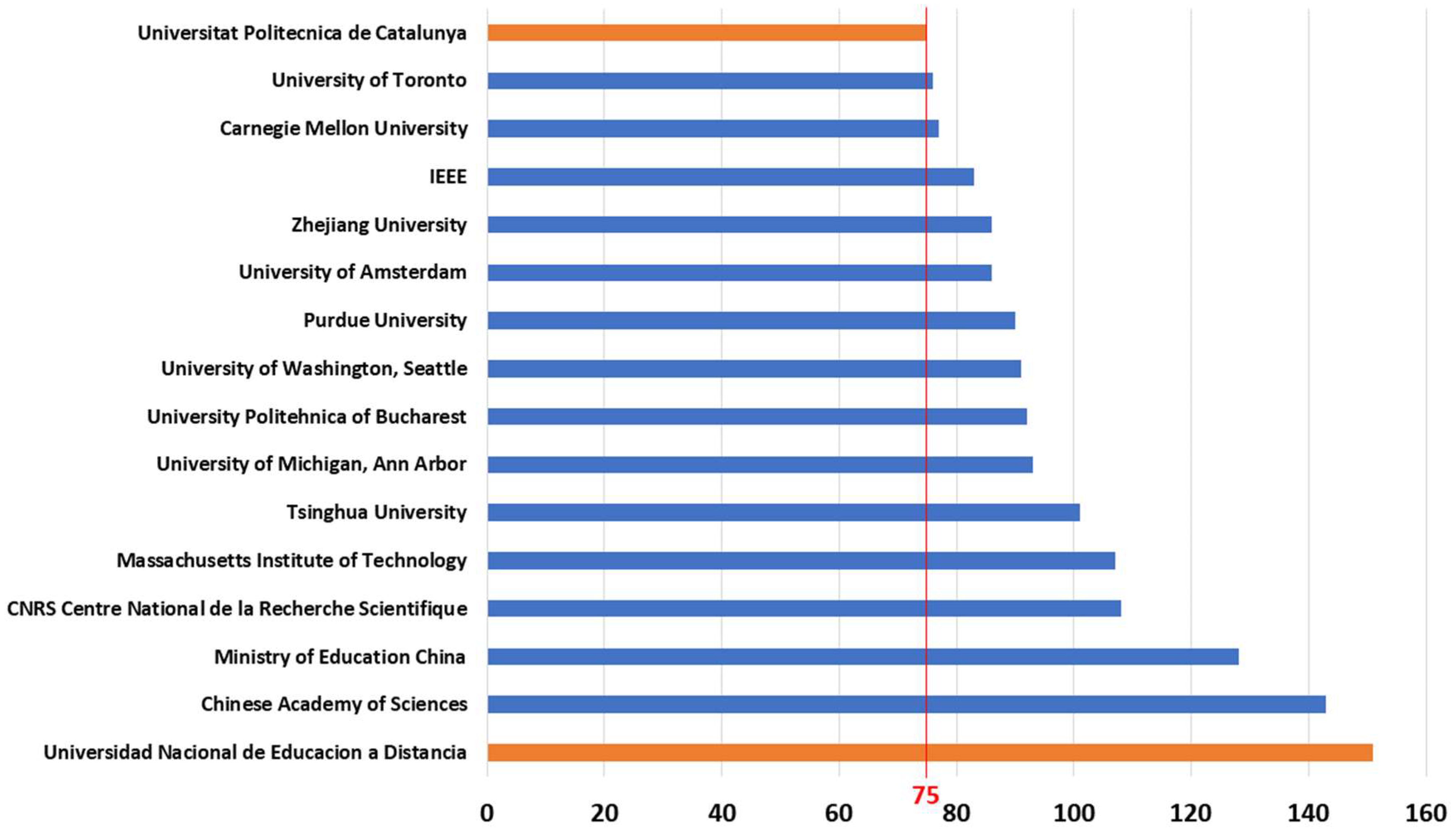
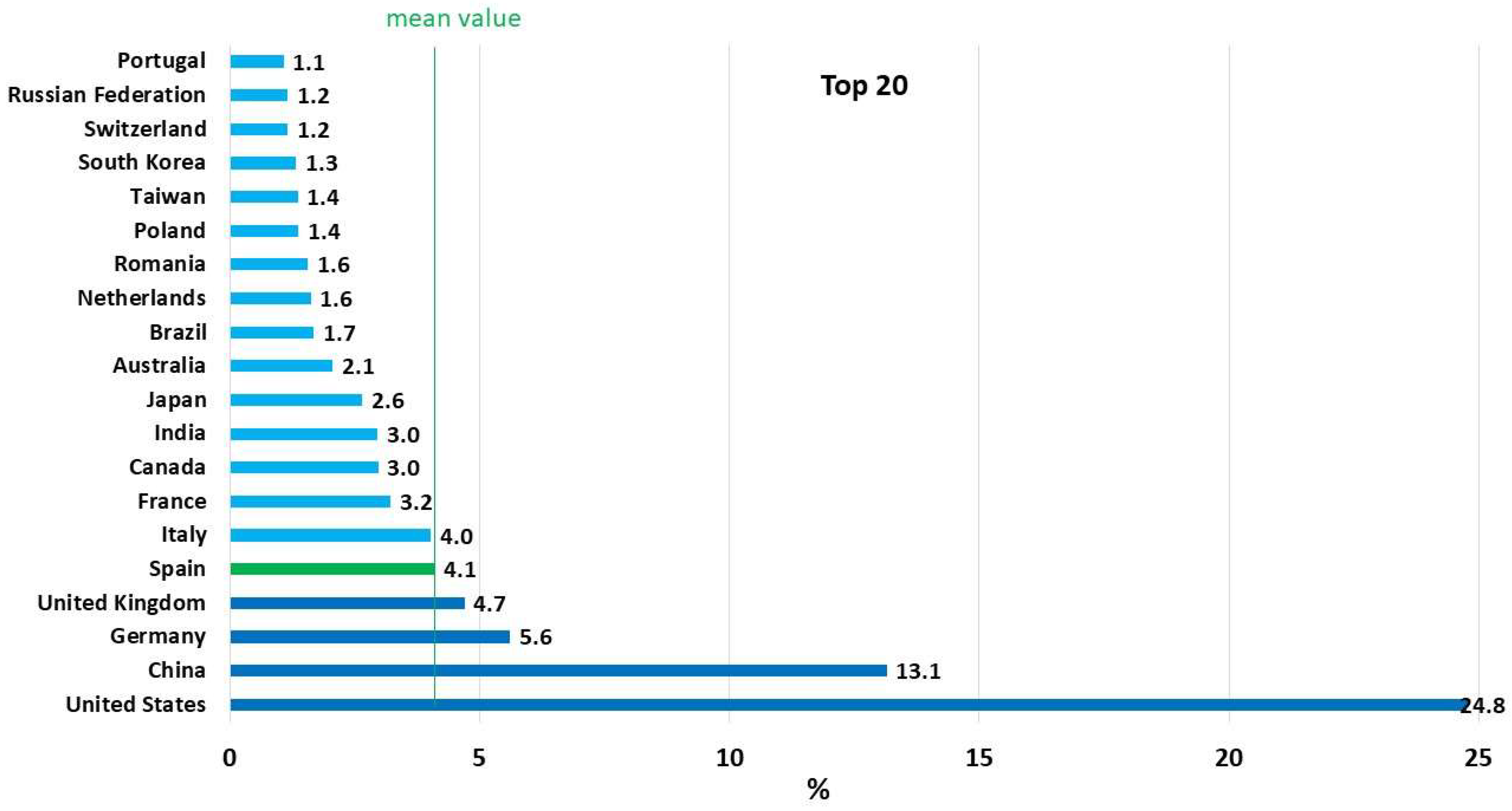
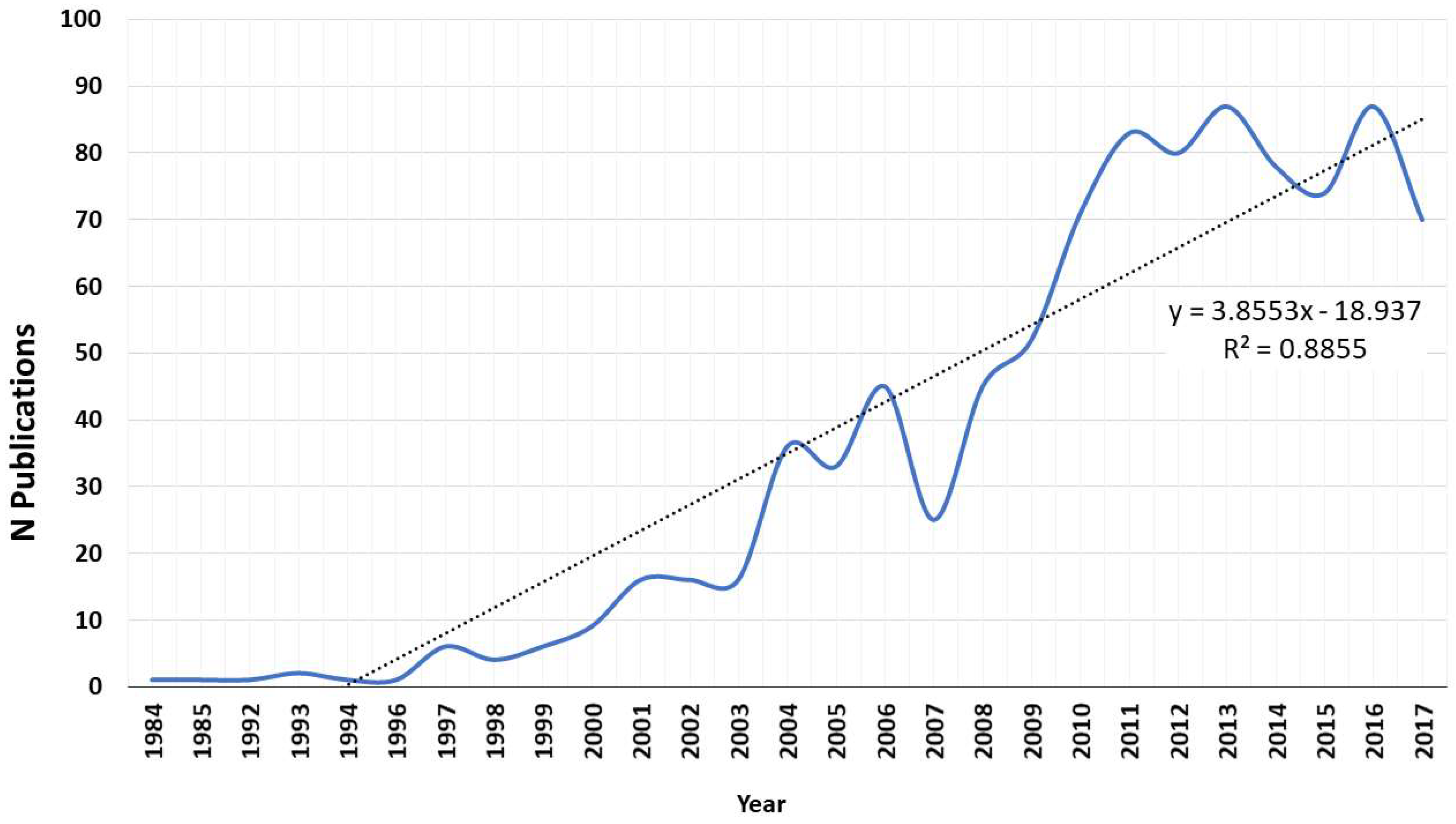
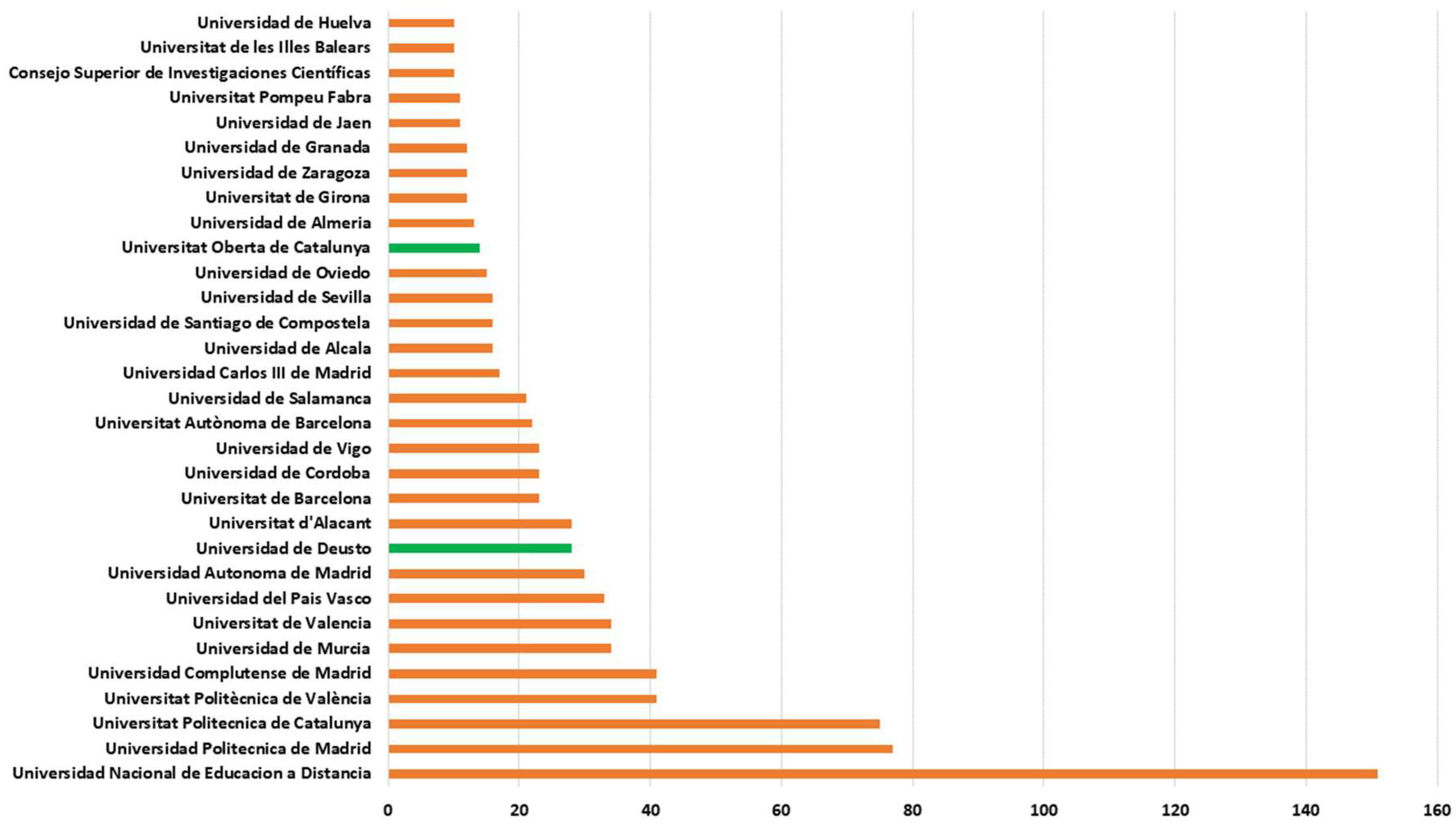
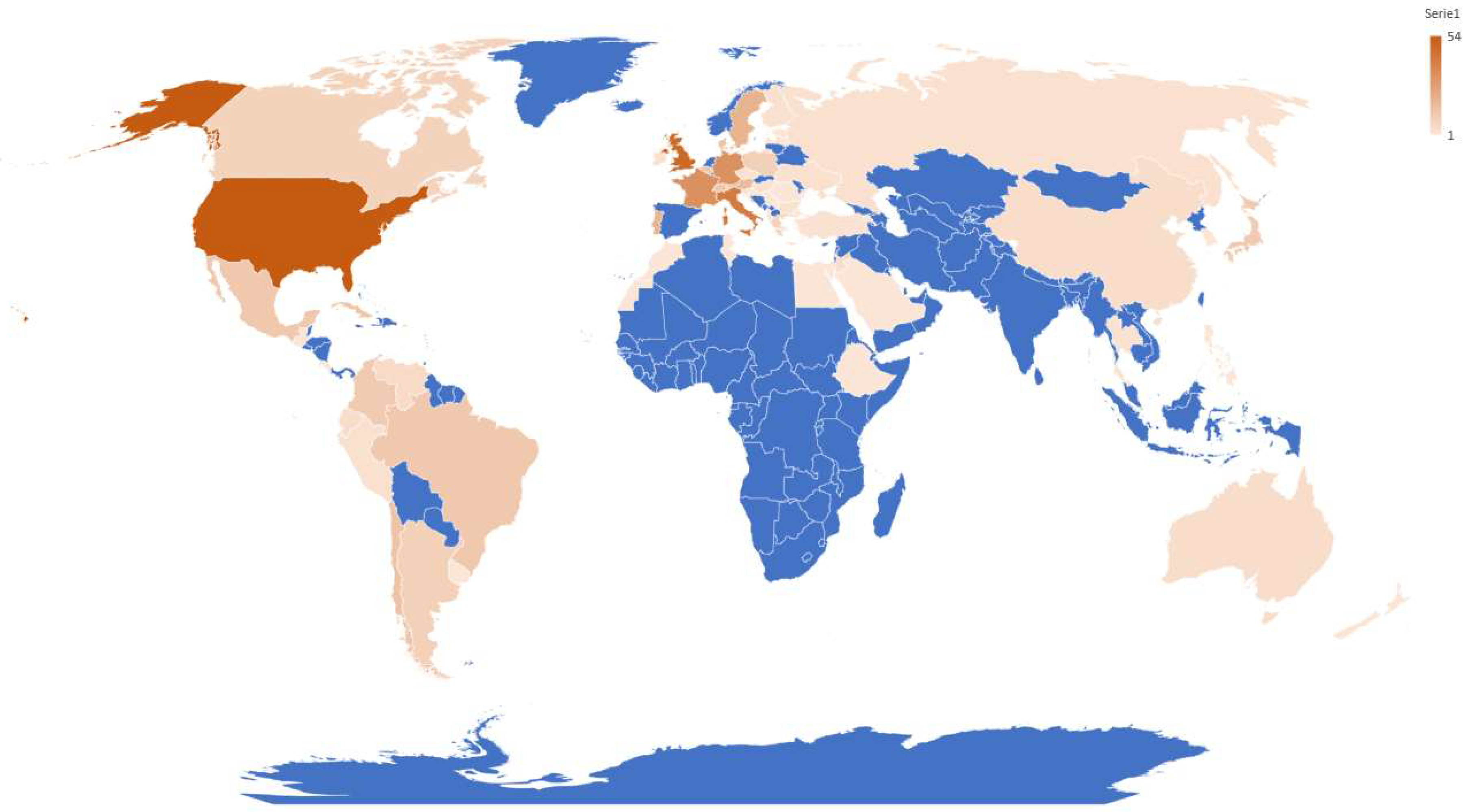
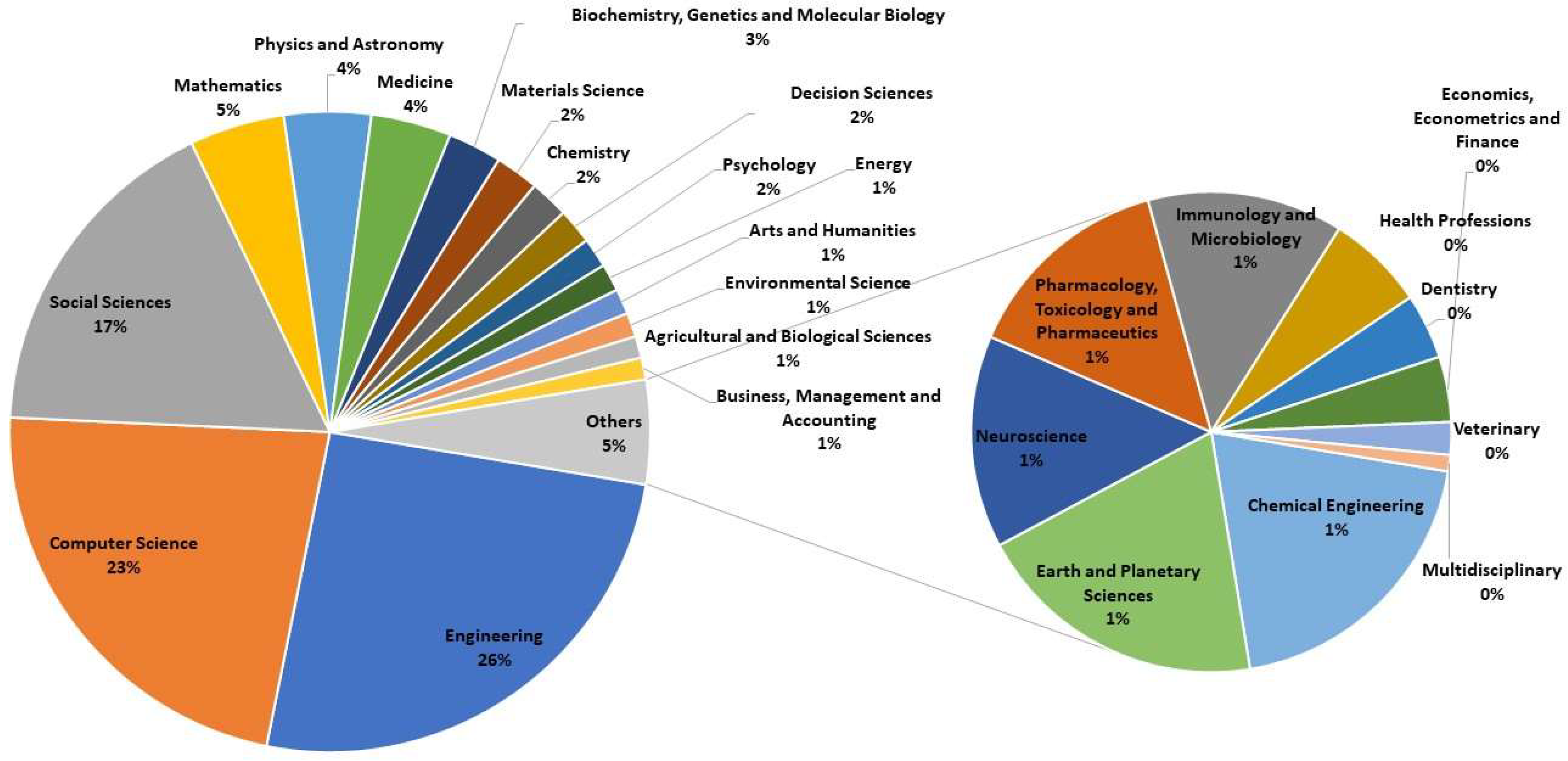
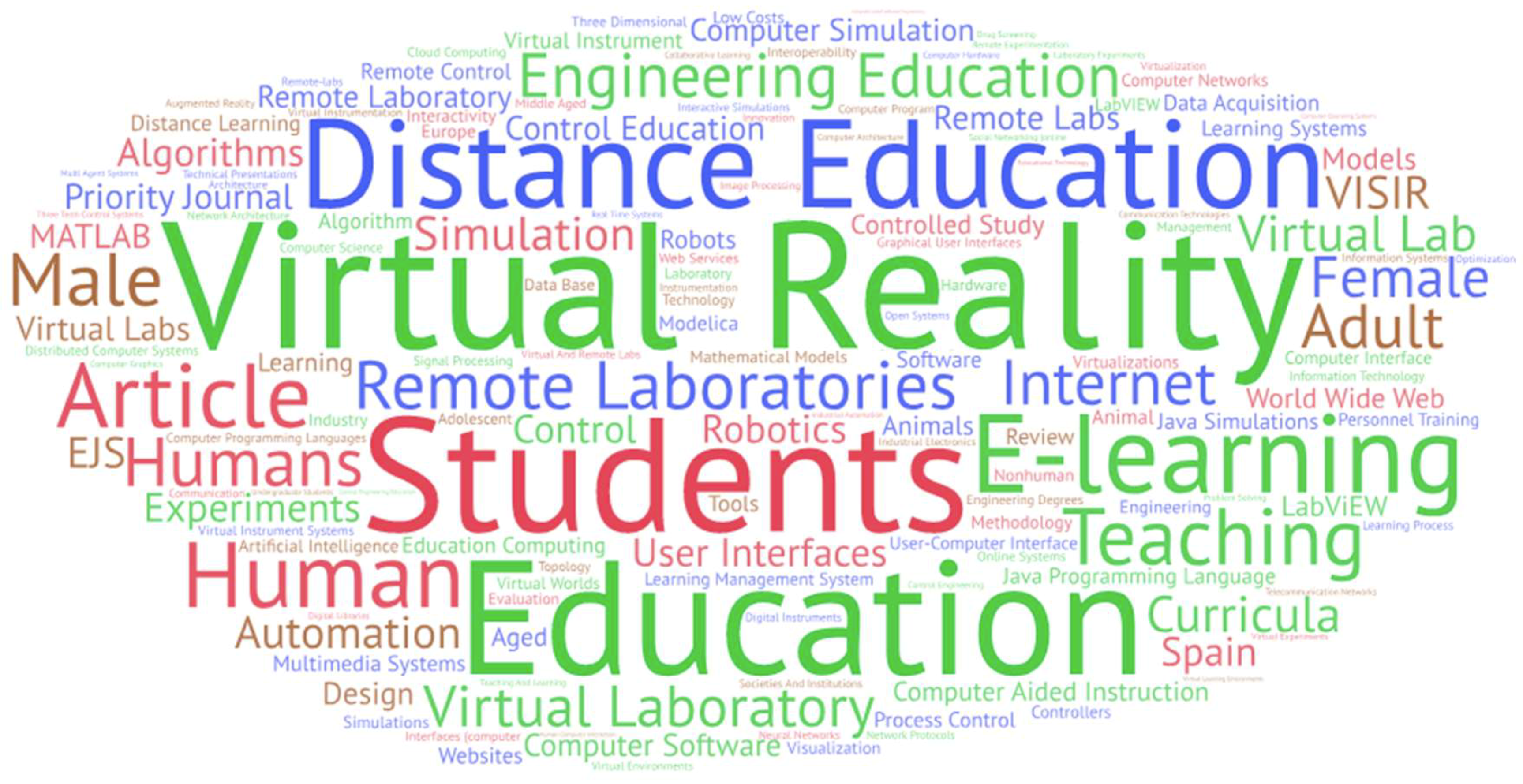
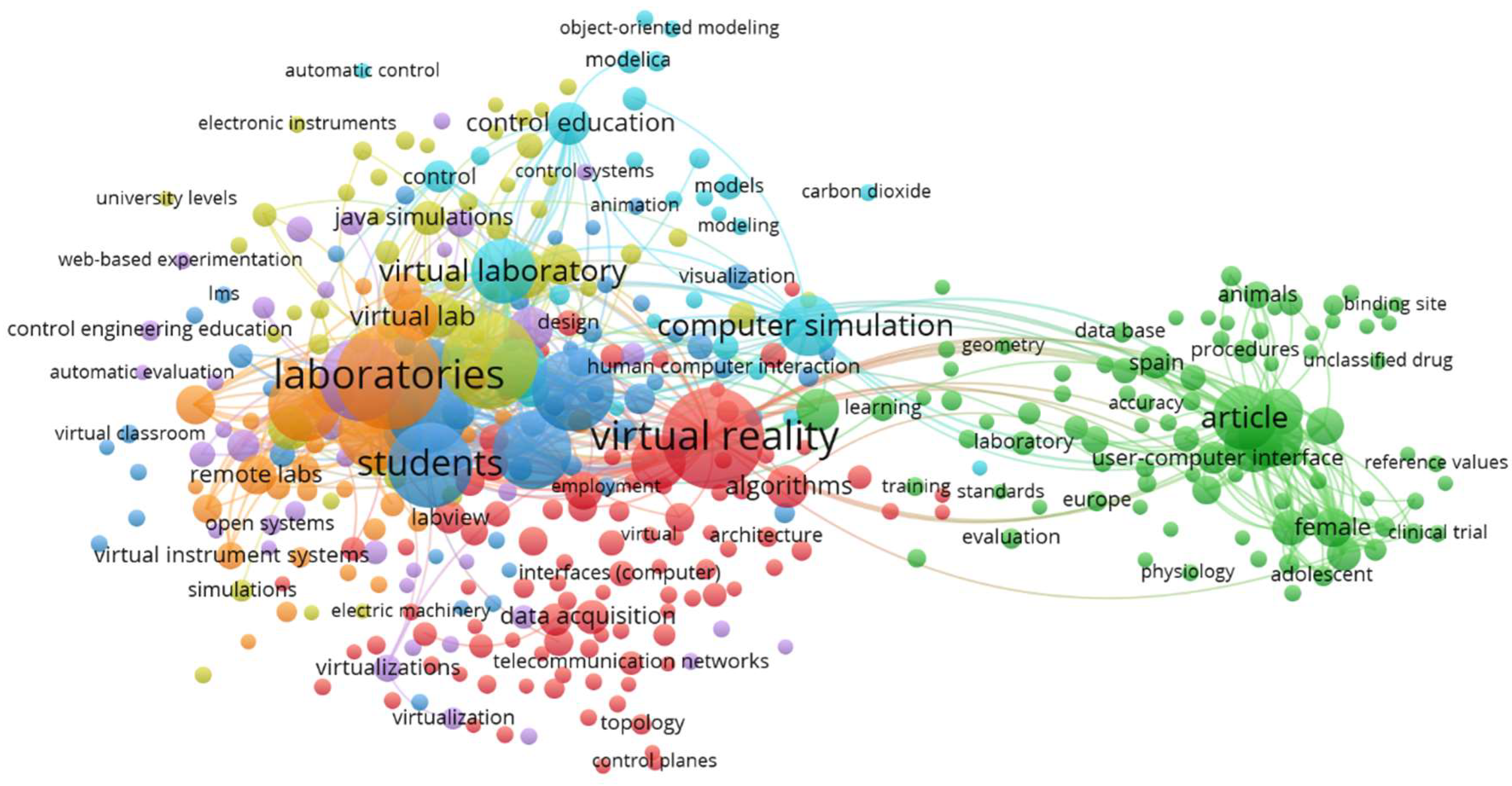
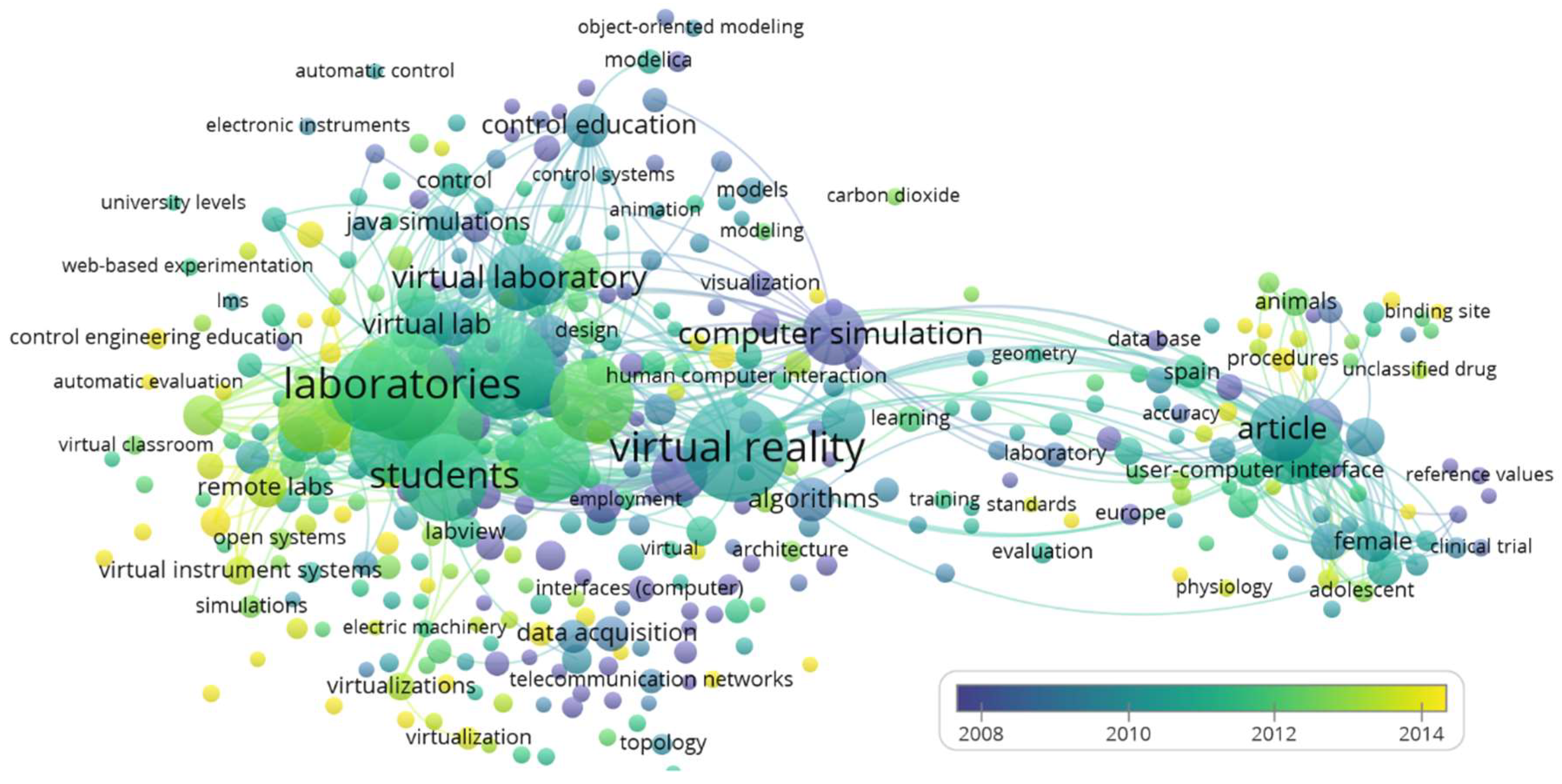
| Institution | Country | Ns | Ns/As | N | TC | TC/N | RN | RTC/N |
|---|---|---|---|---|---|---|---|---|
| Universidad Nacional de Educacion a Distancia | Spain | 250,000 | 19.5 | 151 | 1124 | 7.44 | 1 | 12 |
| Chinese Academy of Sciences | China | 45,000 | 3.1 | 143 | 895 | 6.26 | 2 | 13 |
| Ministry of Education China | China | - | - | 132 | 521 | 3.95 | 3 | 15 |
| CNRS Centre National de la Recherche Scientifique | France | - | - | 114 | 1685 | 14.78 | 4 | 9 |
| Massachusetts Institute of Technology | USA | 11,177 | 8.7 | 111 | 2898 | 26.11 | 5 | 1 |
| Tsinghua University | China | 36,912 | 11.9 | 101 | 1115 | 11.04 | 6 | 10 |
| University of Michigan, Ann Arbor | USA | 44,718 | 6.7 | 93 | 1798 | 19.33 | 7 | 5 |
| University Politehnica of Bucharest | Romania | 25,469 | 18.2 | 92 | 240 | 2.61 | 8 | 16 |
| University of Washington, Seattle | USA | 44,945 | 11.4 | 92 | 2209 | 24.01 | 9 | 2 |
| Purdue University | USA | 41.573 | 13.6 | 92 | 1653 | 17.97 | 10 | 6 |
| University of Amsterdam | Netherland | 23,495 | 12.3 | 88 | 1403 | 15.94 | 11 | 7 |
| Zhejiang University | China | 50,051 | 14.1 | 86 | 344 | 4.00 | 12 | 14 |
| IEEE | USA | - | - | 83 | 1992 | 24.00 | 13 | 3 |
| Carnegie Mellon University | USA | 12,676 | 13.5 | 78 | 1850 | 23.72 | 14 | 4 |
| University of Toronto | Canada | 69,427 | 18.7 | 76 | 1190 | 15.66 | 15 | 8 |
| Conference or Proceeding | Publisher | N | % | TH-Index * | Total Citation (TC) | TC/N | RTC/N |
|---|---|---|---|---|---|---|---|
| Lecture Notes in Computer Science Including Subseries Lecture Notes in Artificial Intelligence and Lecture Notes in Bioinformatics | Springer | 537 | 10.54 | 20 | 2137 | 4.0 | 3 |
| Proceedings of SPIE: The International Society for Optics and Photonics | Society of Photo-optical Instrumentation Engineers | 418 | 8.20 | 12 | 812 | 1.9 | 4 |
| ASEE Annual Conference and Exposition Conference Proceedings | American Society for Engineering Education | 293 | 5.68 | 9 | 424 | 1.4 | 6 |
| Applied Mechanics and Materials | Scitec Publications Ltd. | 289 | 5.67 | 3 | 93 | 0.3 | 11 |
| Advanced Materials Research | Trans Tech Publications | 215 | 4.22 | 3 | 91 | 0.4 | 10 |
| Proceedings Frontiers in Education Conference (FIE) | IEEE Education Society | 125 | 2.45 | 11 | 654 | 5.2 | 2 |
| ACM International Conference Proceeding Series | Association for Computer Machinery | 89 | 1.75 | 5 | 106 | 1.2 | 7 |
| IFAC Proceedings Volumes IFAC Papers online | IFAC Secretariat | 89 | 1.75 | 6 | 162 | 1.8 | 5 |
| AIP Conference Proceedings | AIP (American Institute of Physics) | 74 | 1.45 | 4 | 65 | 0.9 | 9 |
| Communications in Computer and Information Science | Springer Verlag | 71 | 1.39 | 4 | 72 | 1.0 | 8 |
| Studies in Health Technology and Informatics | IOS Press | 71 | 1.39 | 12 | 549 | 7.7 | 1 |
| Journal | Publisher | N | % | TH-Index * | TC | TC/N | RTC/N |
|---|---|---|---|---|---|---|---|
| SAE Technical Papers | SAE International (Society of Automotive Engineers) | 132 | 2.6 | 6 | 215 | 3.2 | 8 |
| International Journal of Online Engineering | Kassel University Press GmbH | 102 | 2.0 | 11 | 324 | 8.8 | 5 |
| Computer Applications in Engineering Education | John Wiley & Sons Inc. | 85 | 1.7 | 18 | 747 | 1.4 | 10 |
| Chinese Journal of Scientific Instrument | Science Press | 84 | 1.6 | 6 | 121 | 26.9 | 1 |
| IEEE Transactions on Education | IEEE Education Society | 72 | 1.4 | 26 | 1940 | 8.7 | 6 |
| International Journal of Engineering Education | Dublin Institute of Technology Tempus Publications | 69 | 1.4 | 17 | 598 | 12.0 | 3 |
| Diagnostic Pathology | BioMed Central | 58 | 1.1 | 16 | 696 | 12.0 | 3 |
| Plos One | Public Library of Science | 53 | 1.0 | 14 | 635 | 4.3 | 7 |
| Transactions of The Chinese Society of Agricultural Engineering | Chinese Society of Agricultural Engineering | 49 | 1.0 | 8 | 212 | 20.2 | 2 |
| IEEE Transactions on Instrumentation and Measurement | Institute of Electrical and Electronics Engineers | 43 | 0.8 | 21 | 867 | 3.2 | 8 |
| Keyword | N |
|---|---|
| Virtual Reality | 217 |
| Students | 154 |
| Distance Education | 147 |
| Education | 141 |
| E-learning | 134 |
| Engineering Education | 131 |
| Teaching | 129 |
| Remote Laboratories | 113 |
| Virtual Laboratory | 90 |
| Article | 86 |
| Human | 86 |
| Computer Simulation | 81 |
| Computer Software | 76 |
| Humans | 70 |
| Internet | 61 |
| Virtual Lab | 49 |
| User Interfaces | 48 |
| Priority Journal | 45 |
| Automation | 43 |
| Computer Aided Instruction | 43 |
| Experiments | 43 |
| Java Programming Language | 42 |
| Remote Laboratory | 39 |
| Simulation | 39 |
| Algorithms | 38 |
| Control Education | 38 |
| Education Computing | 35 |
| Curricula | 34 |
| Female | 32 |
| Learning Management System | 32 |
| Remote Labs | 32 |
| World Wide Web | 31 |
| University | 1 | 2 | 3 |
|---|---|---|---|
| Universidad Nacional de Educación a Distancia | Distance Education | Remote Laboratories | Engineering Education |
| Universitat Politecnica de Catalunya | Virtual Reality | Computer Simulation | Students |
| Universidad Politécnica de Madrid | Virtual Reality | Engineering Education | Students |
| Universitat Politècnica de València | Virtual Reality | Distance Education | Education |
| Universidad Complutense de Madrid | Students | Virtual Reality | Distance Education |
| Universidad de Murcia | Java Programming Language | Computer Software | Distance Education |
| Universitat de Valencia | Human | Virtual Reality | Virtual Teams |
| Universidad Autónoma de Madrid | Virtual Reality | Distance Education | Education |
| Universidad de Deusto | Remote Laboratories | Virtual Instrument Systems | E-learning |
| Universitat d’Alacant | E-learning | Students | User Interfaces |
| Cluster | Color | Keywords | N | Proposed Name |
|---|---|---|---|---|
| 1 | Red | Virtual reality, algorithms, internet, world wide web, data acquisition | 97 | Virtual reality |
| 2 | Green | Human, humans, user computer interface, male, female | 92 | Users |
| 3 | Blue | E-learning, students, teaching, computer aided instruction, curricula, virtual learning environments | 57 | E-learning |
| 4 | Yellow | Education computing, experiments, java programming language, biomedical engineering, electronics industry | 52 | Computer science |
| 5 | Purple | Distance education, automation, process control, robots | 41 | Automatic and robotics |
| 6 | Sky Blue | Computer simulation, computer software, modelica language, object oriented modelling | 30 | Computer simulation |
| 7 | Orange | Engineering Education, remote laboratories, learning management systems, virtual instrument systems, augmented reality | 30 | Engineering Education |
© 2018 by the authors. Licensee MDPI, Basel, Switzerland. This article is an open access article distributed under the terms and conditions of the Creative Commons Attribution (CC BY) license (http://creativecommons.org/licenses/by/4.0/).
Share and Cite
Salmerón-Manzano, E.; Manzano-Agugliaro, F. The Higher Education Sustainability through Virtual Laboratories: The Spanish University as Case of Study. Sustainability 2018, 10, 4040. https://doi.org/10.3390/su10114040
Salmerón-Manzano E, Manzano-Agugliaro F. The Higher Education Sustainability through Virtual Laboratories: The Spanish University as Case of Study. Sustainability. 2018; 10(11):4040. https://doi.org/10.3390/su10114040
Chicago/Turabian StyleSalmerón-Manzano, Esther, and Francisco Manzano-Agugliaro. 2018. "The Higher Education Sustainability through Virtual Laboratories: The Spanish University as Case of Study" Sustainability 10, no. 11: 4040. https://doi.org/10.3390/su10114040
APA StyleSalmerón-Manzano, E., & Manzano-Agugliaro, F. (2018). The Higher Education Sustainability through Virtual Laboratories: The Spanish University as Case of Study. Sustainability, 10(11), 4040. https://doi.org/10.3390/su10114040






